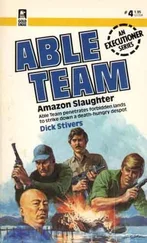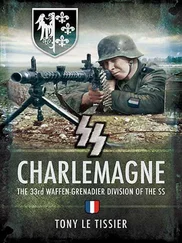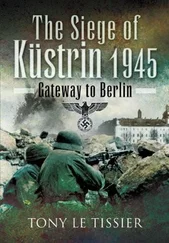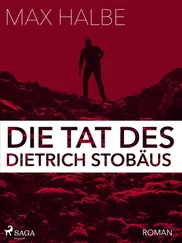Since movement within the pocket could not be concealed from the Soviets, they pressed hard upon the weak securing units from east of the Dahme. As there were no longer any heavy weapons available, the German troops had to resort to their own resources and counterattacked in classic style, using hand grenades, spades and sub-machine guns. Among them was the Mathiebe Combat Team from 1st Battalion, 86th Grenadier Regiment Schill , which retook the area around the Streganz brickworks and held on to it. This defensive battle, which also included the retaking of Hermsdorf by the combat team, went on all day.
SS-Lieutenant Bärmann of the 32nd SS Tank-Hunting Battalion wrote:
Our divisional staff were in Hermsdorf, where a general was directing traffic with a pistol in his hand. Only in this way could panic be prevented, and the streams of traffic flow in orderly fashion.
The headquarters moved on to the Hammer forestry office, which first had to be cleared of its Russian occupants, but they had to leave 2,000 wounded behind in Hermsdorf in the care of their last two medical officers and some medical orderlies. [39] Tieke, Das Ende zwischen Oder und Elbe , pp. 310–11.
The outward flow of troops and refugees remained sluggish, being constantly interrupted by attacking aircraft and heavy artillery fire. Nothing was known of developments at the break-out point. Stragglers and soldiers who had distanced themselves from their units mingled with endless streams of refugees moving this way and that all day long through the narrow pocket, attracting the Russian aircraft like moths to a flame. The dead and wounded could no longer be tended to or made safe. Apart from the lack of ammunition, there was also a lack of bandages and medical supplies. Doctors and medical orderlies were scarcely to be seen. [40] Wilke, Am Rande der Strassen , p. 55.
The SS-second lieutenant of Battlegroup Becker , which was still within the main pocket, continued his account:
On 28 April we moved as the last unit and, after a few kilometres, occupied a new position on a small height near a village. The Russians came across the open ground and attacked us with loud cries. Aircraft pinned us down and it became a bitter fight. We had to repel their attacks four times, mainly in close combat with some indescribable scenes.
Our ammunition ran out in the afternoon, but a runner appeared at the last moment carrying several boxes of ammunition, and we made a counterattack with 50 men, the rest being incapable of taking part. Wounded Russians were screaming, and some of the barns and houses had caught fire. We could not have withstood another Russian attack.
Soldiers who rejoined our unit later reported that a so-called Seydlitz officer had said to them: ‘Just tell them that their positions are about to be attacked by two battalions to force a way into the pocket and split up the remaining units.’
We received the order to abandon our positions at 2100 hours on this terrible day. We were to proceed towards Halbe via Hermsdorf. Unfortunately, the sounds of fighting in front of us had become even stronger. Suddenly we were unable to go on. A wounded soldier came back and said that Halbe was seven kilometres away and that there had already been two days of bitter fighting there with a frightful number of dead. [41] Ibid ., pp. 83–4.
That afternoon the Schill and Hutten Infantry Divisions of General Wenck’s 12th Army continued their advance towards Potsdam. Lieutenant-General Engel of the Schill Division deployed two regiments of infantry, the SPGs and two platoons of tanks in his spearhead, using APCs and armoured cars to cover the flanks.
The Scharnhorst and Körner Infantry Divisions were equally heavily engaged around Beelitz, where an attack on the sanatorium located in the woods outside the town met bitter resistance. The approach to the sanatorium was blocked by a strongly defended transformer building which had first to be reduced by anti-tank gunfire before fighting for the hospital buildings could begin. There the Soviets conducted their defence from the underground corridors connecting the individual buildings – even though the corridors were filled with 3,000 sick and wounded. As soon as the Germans had taken the first building, the evacuation of the patients with their medical attendants was begun. With them were some representatives of the International Red Cross who later negotiated their acceptance by the American forces on the Elbe. [42] Wenck, ‘Berlin war nicht mehr zu retten’, pp. 65–6; Gellermann, Die Armee Wenck , pp. 85–6. Patients from the main civilian and military hospitals in Berlin and Potsdam had been evacuated here to a lung clinic and adjacent barracks (Ramm, Gott Mit Uns , p. 228). General Koehler, in a letter written to the commander of the 83rd US Infantry Division on 26 April appealing for the acceptance of the sick and wounded, anticipated finding 6,000 in his operational area, so it is possible that there were something like this figure recovered overall.
The area now held, extending along the line Nichel–Reesdorf–railway junction north of Beelitz-Ferch, and including Elsholz, Buchholz and Brachwitz, provided a suitable catchment area for receiving break-out groups from either Berlin, Potsdam or Halbe. A situation report by 12th Army read:
The enemy has been able to penetrate Potsdam from the north. Our own attack thrust forward with the right wing farther to the east, taking Salzbronn and Elsholz. Hard fighting around Beelitz. North of there leading elements of the Scharnhorst Division have reached the railway crossing six kilometres north of Beelitz. Spearheads of the Hutten Division have taken Ferch. Striking along the Schwielowsee during the night. [43] Lakowski/Stich, Der Kessel von Halbe 1945 , p. 113.
The suggestion was then sent to 9th Army to concentrate its efforts towards the Beelitz area, where the Soviet forces were relatively weak and scattered over a wide area, providing the only reasonable chance of success. The 12th Army would try to hold its ground as long as possible against the already increasing pressure. A signal received from the OKW ordering 12th Army to close up to the line of the Havel between the Schwielowsee and Brandenburg was ignored. [44] Gellermann, Die Armee Wenck , pp. 87–9.
Meanwhile, acting on orders received the day before, 4th Guards Tank Army’s 5th Guards Mechanized Corps took up the offensive from its positions along the line Buchholz–Treuenbrietzen and seized the villages of Brachwitz and Schlalach in the swampy terrain beyond the railway line to the west in some bitter fighting. The Soviets claimed to have destroyed six SPGs in this engagement. [45] Kreisleitung Jüterbog booklet, p. 26.
ELEVEN
Breaching Koniev’s Lines
29 APRIL 1945
The repeated attacks by the German armour finally succeeded. The Soviet cordon was breached and their positions overrun. The Red Army troops at Halbe were unable to close the gap fast enough, their artillery and tank fire failing to smash the desperate German assault.
Before it was full light on 29 April the German commanders had to get their people flooding through this breach. It was a hectic scramble, but XI SS Panzer Corps and V Corps managed to get through and away. For the rearguard, as will be recounted later, it was not so easy. It seems that the Soviets also managed to block the gap before V SS Mountain Corps could get through, and that this formation then had to bear the brunt of the Soviet artillery fire in its own struggle to break through an area already strewn with the casualties of the earlier fighting. [1] Lakowski/Stich, Der Kessel von Halbe 1945 , p. 121.
Читать дальше












